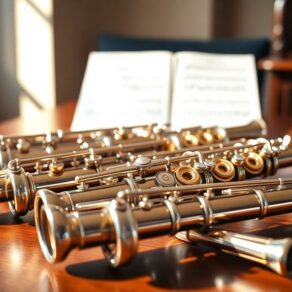Exploring extended techniques in wind instrument performance offers a nuanced approach to musical expression, elevating traditional playing methods to innovative realms. Circular breathing serves as a cornerstone for uninterrupted sound production, but what lies beyond this fundamental skill? By venturing into the realm of overtones, harmonics, and unconventional tonal manipulations, musicians can sculpt intricate sonic landscapes that defy convention. However, the true artistry emerges when these techniques intertwine with live electronics and effects, pushing the boundaries of sound manipulation and artistic expression. The journey into these uncharted territories promises a tapestry of sonic possibilities waiting to be unraveled.
Key Takeaways
- Circular breathing integrates inhalation and exhalation seamlessly for uninterrupted music.
- Tonal manipulation includes overtones, harmonics, microtonal, and quarter-tone techniques for depth and richness.
- Artistic expression techniques involve multiphonics, split tones, percussive effects, and vocal effects for unique sounds.
- Innovative sound manipulation with live electronics breaks tonal constraints and evokes emotional responses.
- Integration of technology like live electronics and effect pedals enhances expressive potential and creates immersive sonic landscapes.
Circular Breathing Technique
The mastery of circular breathing entails a seamless integration of inhalation and exhalation, allowing for an uninterrupted flow of music production. This advanced technique is a game-changer for wind instrument players, enabling them to produce a continuous sound without breaks. Central to circular breathing is breath control, a skill that requires precise coordination of respiratory muscles. Endurance training is crucial for developing the ability to maintain a steady airflow while simultaneously replenishing oxygen through the nose.
Breath control lies at the heart of circular breathing, demanding disciplined airflow management. Players must learn to regulate their breath to sustain notes for extended periods, a task that necessitates both physical and mental stamina. Endurance training plays a vital role in fortifying respiratory muscles, ensuring that musicians can execute complex musical passages seamlessly. By honing their ability to control inhalation and exhalation, performers can achieve a fluid and continuous sound that captivates audiences.
Through dedicated practice and focused training, musicians can master the art of circular breathing. This technique not only showcases technical proficiency but also enhances the expressiveness of musical interpretations. By embracing breath control and endurance training, performers can unlock new possibilities in their playing, pushing the boundaries of traditional musical performance. Circular breathing opens doors to a world of musical exploration, empowering musicians to create captivating performances that resonate deeply with listeners.
Implementing Overtones and Harmonics
Implementing overtones and harmonics enhances the depth and richness of musical expression, elevating the sonic landscape for wind instrument players. Overtones exploration involves producing higher pitches along with the fundamental note by controlling the airspeed, embouchure, and fingerings. By delving into overtones, musicians unlock a spectrum of additional tones that add complexity and color to their music. This technique allows for a more resonant and vibrant sound, expanding the sonic possibilities of the instrument.
Harmonics utilization is another crucial aspect of creating a captivating musical performance. By selectively emphasizing specific harmonics through altered fingerings and air pressure, musicians can produce a series of interconnected tones above the fundamental pitch. This not only enriches the timbre but also creates a mesmerizing effect that captivates listeners. Harmonics add a layer of sophistication and depth to the music, creating a multidimensional auditory experience that showcases the player's technical prowess and artistic sensitivity.
Exploring overtones and harmonics requires dedication and practice, as mastering these techniques can significantly enhance a player's musicality. By incorporating these advanced techniques into their repertoire, wind instrument players can elevate their performances to new heights, captivating audiences with the intricate tapestry of sounds they create.
Multiphonics and Split Tones
Delving into the realm of advanced wind instrument techniques reveals a fascinating world of multiphonics and split tones, offering musicians new avenues for sonic exploration and artistic expression. Multiphonics involve playing more than one pitch simultaneously on a wind instrument, creating rich and complex sounds. Split tones, on the other hand, entail producing two distinct pitches through manipulation of embouchure and air pressure. These extended techniques are commonly utilized in avant-garde music and contemporary classical compositions, pushing the boundaries of traditional performance practices. Musicians who delve into the realm of multiphonics and split tones often find themselves immersed in a world of experimentation and innovation, where improvisation plays a crucial role in shaping their sonic landscapes.
| Multiphonics | Split Tones |
|---|---|
| *Playing multiple pitches simultaneously* | *Producing two distinct pitches* |
| *Requires control and precision* | *Involves manipulation of embouchure* |
| *Common in avant-garde music* | *Utilized in contemporary classical compositions* |
| *Offers new possibilities for artistic expression* | *Pushes the boundaries of traditional performance* |
Exploring these techniques not only expands a musician's technical abilities but also opens up a world of creativity and expression. By incorporating multiphonics and split tones into their repertoire, performers can add depth and complexity to their musical interpretations, creating unique and captivating performances that resonate with audiences seeking innovative sounds.
Percussive and Vocal Effects
Exploring further into the realm of advanced wind instrument techniques, musicians can uncover a rich tapestry of percussive and vocal effects that offer unique avenues for artistic innovation and expressive exploration. Body percussion, a technique where the player uses different parts of their body to create rhythmic sounds while playing the instrument, adds a dynamic element to the music. By incorporating body percussion, musicians can enhance the overall performance and engage the audience in a visually captivating manner. This technique requires practice to synchronize the movements seamlessly with the music to maintain a cohesive and rhythmic flow.
Another intriguing aspect of extended wind instrument techniques is throat singing. Originating from various cultures, throat singing involves producing multiple pitches simultaneously by manipulating the vocal cords. This unique vocal effect adds a mystical and ethereal quality to the music, creating a mesmerizing sonic landscape. Throat singing can be integrated into wind instrument performances to add depth and texture, expanding the sonic possibilities of the music.
Microtonal and Quarter-Tone Techniques
What complexities and nuances do microtonal and quarter-tone techniques bring to the realm of wind instrument performance?
Exploring unique intonations through microtonal and quarter-tone techniques opens up a world of sonic possibilities for wind instrumentalists. By incorporating these techniques, musicians can achieve subtle variations in pitch that add depth and richness to their performances. Microtonal improvisation allows for the exploration of the spaces between traditional Western scales, unlocking a new level of expressiveness and creativity.
When wind instrumentalists delve into microtonal and quarter-tone techniques, they must navigate the intricate terrain of intonation with precision and sensitivity. These techniques require a heightened awareness of pitch and tuning, challenging musicians to expand their sonic palette and push the boundaries of conventional Western music. By embracing microtonal and quarter-tone techniques, performers can create music that is both innovative and captivating, captivating audiences with its unique and otherworldly sound.
Incorporating microtonal improvisation into wind instrument performance can lead to truly transformative musical experiences. By exploring the spaces between the notes, musicians can break free from traditional constraints and tap into a realm of unlimited sonic possibilities. Through experimentation and practice, wind instrumentalists can harness the power of microtonal and quarter-tone techniques to create music that is both technically challenging and emotionally compelling, pushing the boundaries of what is possible in the world of wind instrument performance.
Live Electronics and Sound Manipulation
Embarking on a sonic journey enriched with modern innovation, wind instrumentalists are increasingly integrating live electronics and sound manipulation techniques to expand the horizons of their musical expression. In the realm of live performance, the fusion of traditional wind instruments with cutting-edge sound design technologies opens up a myriad of possibilities for musicians to craft unique and immersive sonic landscapes.
Live electronics offer wind instrumentalists the ability to manipulate and transform their sound in real-time, pushing the boundaries of what is sonically achievable in a live setting. Through the use of effect pedals, loop stations, and software applications, performers can layer textures, modify timbres, and experiment with novel sonic effects, enhancing the overall musical experience for both themselves and their audience.
Moreover, the integration of sound manipulation techniques allows wind instrumentalists to break free from conventional tonal constraints, enabling them to explore new sonic territories and create innovative compositions that transcend traditional musical boundaries. By harnessing the power of live electronics, musicians can sculpt dynamic soundscapes that captivate listeners and evoke emotional responses, inviting them to delve deeper into the sonic tapestries woven before them.
In essence, the marriage of wind instruments with live electronics and sound manipulation not only enriches the expressive potential of performers but also invites audiences to partake in a sensory journey that blurs the lines between acoustic and electronic realms, forging a new path forward in the ever-evolving landscape of contemporary music.
Frequently Asked Questions
Can Extended Techniques Be Used in All Genres of Music?
Extended techniques can indeed be utilized across a wide spectrum of musical genres. From jazz fusion to classical crossover, these innovative techniques add depth and creativity to musical compositions. By incorporating extended techniques, musicians can push the boundaries of traditional music and create unique sounds that captivate audiences.
Whether it's through circular breathing, unconventional vocalizations, or experimental instrumental techniques, embracing extended techniques can enhance the richness and diversity of music in various genres.
Are Extended Techniques Suitable for Beginner Musicians?
Extended techniques can pose challenges for beginner musicians due to their advanced skill level and steep learning curve. While these techniques offer unique benefits such as expanding musical expression and creativity, beginners may find them overwhelming initially.
It is essential for novice musicians to focus on mastering traditional techniques before delving into extended ones to avoid frustration and limitations in their musical development. Gradual exposure and guidance can help beginners eventually embrace and excel in using extended techniques.
How Can Extended Techniques Enhance Musical Expression?
Extended techniques can significantly enhance musical expression by allowing musicians to explore new sounds, textures, and emotions beyond traditional playing methods. These techniques, such as circular breathing, can enhance creativity by offering unique ways to convey musical ideas.
Additionally, mastering these techniques can improve control over tone, dynamics, and articulation, providing musicians with a broader palette to express themselves artistically and connect with their audience on a deeper level.
Are There Any Health Concerns Associated With These Techniques?
Musician's health is paramount. When delving into extended techniques like circular breathing, potential risks can arise. These techniques, when not practiced mindfully, may lead to issues such as hyperventilation or strain on respiratory muscles.
Prevention strategies include proper warm-ups, gradual progression, and seeking guidance from experienced instructors. Remember, a healthy musician creates beautiful music. Prioritize your well-being to ensure longevity in your musical journey.
Can Extended Techniques Be Adapted for Different Instruments?
Adapting techniques to suit different instruments showcases the versatility and creativity within music. By modifying extended techniques, musicians can explore unique sounds and push the boundaries of traditional performance.
Instrument versatility allows for innovative interpretations across various musical genres and styles, fostering a rich tapestry of artistic expression. Embracing these adaptations opens up a world of possibilities, encouraging musicians to experiment and seek new ways to connect with their audience through their chosen instrument.
Conclusion
In exploring extended techniques in wind instrument performance, musicians unlock a world of sonic possibilities.
From the rhythmic precision of circular breathing to the rich textures of overtones and harmonics, each technique adds a layer of complexity and depth to musical compositions.
By embracing unconventional approaches like multiphonics and microtonal techniques, performers can create immersive soundscapes that push the boundaries of traditional music.
With live electronics and effects pedals, the potential for sonic experimentation and artistic expression is limitless.



